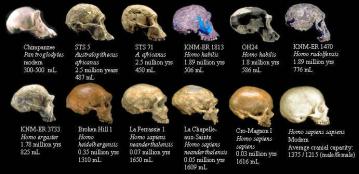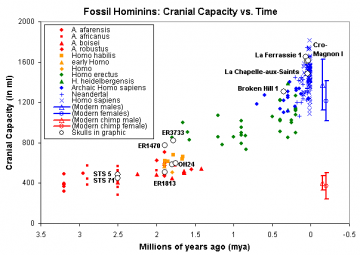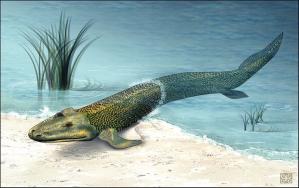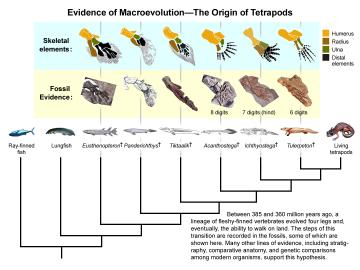Are Transitional fossils are extremely rare?
Summary of problems with claim:
Fossils with transitional morphology are not rare. Fossils illustrating the gradual origin of humans, horses, rhinos, whales, seacows, mammals, birds, tetrapods, and various major Cambrian "phyla" have been discovered and are well-known to scientists. Explore Evolution's claims to the contrary are just a rehash of older creationist arguments on this point, relying on out-of-context quotes, confusion over terminology and classification, and ignoring inconvenient evidence."Though a possible whale-to-mammal transitional sequence has recently been unearthed, critics maintain that transitional sequences are rare, at best. For this reason, critics argue that Darwin's theory has failed an important test.Explore Evolution, p. 27
Scientists have long thought that amphibians were a transitioinal form between aquatic and land-dwelling life forms. Why? Because amphibians can live in both the water and on land. Yet, the fossil record has revealed at least two problems with this idea... land-dwelling amphibians, themselves, appear suddenly in the fossil record.Explore Evolution, p. 27
Darwin himself was well aware of the problems that the fossil record posed for his theory. Where were the multitudes of transitional forms connecting different groups, as predicted (and expected) by his theory?Explore Evolution, p. 30
Some critics say neo-Darwinism is not consistent with fossil data. Other critics say that punctuated equilibrium is consistent with fossil evidence, but lacks and adequate mechanism. Critics of both views argue that there are still far fewer transitional forms in the fossil record than we would expect, even if new forms of life did arise quickly.Explore Evolution, p. 33
Full discussion:
First, a note on terminology. The phrase "neo-Darwinism" is not widely used by scientists, and may reflect a desire by creationists to dismiss Darwin's ideas merely as another "-ism," rather than a robust scientific theory. A PubMed search of over 18 million scientific articles found 131 variations on "neo-Darwinism," compared to 226,476 uses of "evolution."
Explore Evolution compounds many errors in attempting to claim that fossils representing evolutionary transitions are rare. The first error is its reliance on concepts like 'missing links' and 'transitional forms'. These terms are outdated and founded in incorrect and archaic ways of categorizing life. Until relatively recently, the classification system used to group living things did not aim to represent true evolutionary relationships, and some groups contained only some descendants of a common ancestor, excluding others. For example, birds were not traditionally placed within the reptiles while the 'Sarcopterygii' (lungfish, coelocanths, etc.) classically excludes tetrapods. When we try to connect these poorly defined groups with the grade school evolutionary view that, "fish gave rise to amphibians, which gave rise to reptiles, which gave rise to ," the problems with the underlying classification system confuse the matter. Some so-called 'fish' were more closely related to amphibians than to other so-called 'fish' and some so-called 'reptiles' were more closely related to non-reptiles (e.g., birds) than they were to other 'reptiles'. Drawing upon discontinuities produced by our misclassification, people sought to find 'transitions' or 'links' between wrongly grouped 'fish' and 'amphibians' or 'reptiles' and 'birds' historically, and quite literally creating the concept of 'missing link' or 'transitional form.'
Fortunately, evolutionary biologists have been doing away with such artificial groups for some time now. We no longer accept that birds evolved from reptiles and that birds are not reptiles themselves - since the term Reptilia now includes birds. Viewing life's history and classification in this more realistic (i.e., evolutionary) context where we name groups based on a common ancestor plus all of it's descendants we come to realize that quite literally, all critters have 'transitional' features. In other words, all living things possess a combination of ancestral and derived traits. The shared derived traits (discussed further in the response to chapter 4) inform us of close relationships, while ancestral traits include ancient features retained from an early evolutionary heritage. For example, salmon which most people wouldn't have any trouble classifying retain paired appendages and jaws ancestral traits shared with species like sharks but also have derived traits like bone that forms from a cartilaginous precursor a trait which sharks do not have, but which tetrapods do. This sort of bone is a derived feature linking salmon as closer relatives of tetrapods than sharks are, even though salmon still have fins and other 'fishy' traits that sharks share.
Does this mean salmon are transitional forms or 'links' between sharks and tetrapods? Were salmon our ancestors? Of course not. The issue is that upon properly classifying life into groups sharing a common ancestor, we see that all of life is characterized by these ancestral and derived traits. Just as salmon did not give rise to tetrapods, frogs are not links between salmon and reptiles. These traits inform us of common ancestry among groups, not a sequential movement of an entire group into another group (e.g., amphibians to reptiles).
As to the actual rarity of fossils illustrating evolutionary transitions, Explore Evolution makes additional errors. First, fossils in general are rare, relative to the actual diversity of life which once existed. The chances of a given species fossilizing are slight. Thus, the fossils referred to as transitional are not necessarily the direct ancestors of modern taxa, but may represent failed branches off of the stem which led to modern forms. Depending where they branched off, they possess some, but not all, of the traits we associate with modern groups, which provides evidence of the form the transition took, even if we lack fossils of the directly ancestral species. Knowing the age of these fossils, we can have substantial certainty about the latest date at which various evolutionary novelties must have originated. Explore Evolution fails to explain what paleontologists actually use fossils to illustrate, sowing confusion among students where it ought to bring clarity.
Given the general rarity of fossils, fossils showing evolutionary transitions are not at all rare. This can be illustrated with a range of examples, of which the record of hominid fossils is especially striking. The skulls shown below display a clear, smooth transition from the early ancestors of modern humans to the modern form of the human skull. A wag might suggest that there is a gap between each of those fossils, and demand a transitional fossil to fill each such gap. Because this evolutionary sequence is relatively recent, there are enough fossils that we can only show the full transition with graphs like the one below.  Fossil hominid skulls: Labeled with specimen name, species, age, and cranial capacity in milliliters (cranial capacity is the volume of the space inside the skull, and correlates closely with brain size). Images 2000 Smithsonian Institution, modified from: TalkOrigins Common Ancestry FAQ
Fossil hominid skulls: Labeled with specimen name, species, age, and cranial capacity in milliliters (cranial capacity is the volume of the space inside the skull, and correlates closely with brain size). Images 2000 Smithsonian Institution, modified from: TalkOrigins Common Ancestry FAQ
That graph illustrates one particular aspect of human evolution, the growth of the brain over the last 3.5 million years of human evolution. At no point could anyone credibly point to a discontinuity between our australopithecine ancestors and modern humans which is not filled by some ancestral fossil form.
 Ages and cranial capacity data: C. De Miguel and M. Henneberg (2001). "Variation in hominid brain size: How much is due to method?" Homo 52(1), pp. 3-58. Cranial capacity of modern humans: McHenry et al. (1994). "Tempo and mode in human evolution." Proceedings of the National Academy of Sciences, 91:6780-6. Graphic by Nick Matzke, National Center for Science Education. May be freely reproduced for nonprofit educational purposes. As we look at events further back in time, the chances of a fossil surviving decrease, so forms of life from the more distant past tend to show larger gaps - greater morphological variation - between fossils. Nonetheless, new fossils are constantly being found which shrink the gaps between ancient species, such that cases once presented by creationists as insurmountable problems for evolution are now textbook examples of fossil transitions. Indeed, of the two sources Explore Evolution cites to support the claim that "Paleontologists have identified many gaps that remain to be filled in the fossil record" (p. 20), only one actually addresses the quality of the fossil record, and it is from 1981. Even that paper does not support the claim that such gaps reflect an absence of transitional forms. Everett C. Olson wrote:
Ages and cranial capacity data: C. De Miguel and M. Henneberg (2001). "Variation in hominid brain size: How much is due to method?" Homo 52(1), pp. 3-58. Cranial capacity of modern humans: McHenry et al. (1994). "Tempo and mode in human evolution." Proceedings of the National Academy of Sciences, 91:6780-6. Graphic by Nick Matzke, National Center for Science Education. May be freely reproduced for nonprofit educational purposes. As we look at events further back in time, the chances of a fossil surviving decrease, so forms of life from the more distant past tend to show larger gaps - greater morphological variation - between fossils. Nonetheless, new fossils are constantly being found which shrink the gaps between ancient species, such that cases once presented by creationists as insurmountable problems for evolution are now textbook examples of fossil transitions. Indeed, of the two sources Explore Evolution cites to support the claim that "Paleontologists have identified many gaps that remain to be filled in the fossil record" (p. 20), only one actually addresses the quality of the fossil record, and it is from 1981. Even that paper does not support the claim that such gaps reflect an absence of transitional forms. Everett C. Olson wrote: The problem of the existence of linkages and phylogenies at the species and generic levels has been much reduced during the last one hundred and twenty years. How this reduction supports or denies Darwin's concepts of phyletic gradualism is still a matter of interpretation of the evidence. At familial and higher levels, the establishment of linkages between categories has been much less successful, and decreasingly so at each successive higher level. Under the very best circumstances, however, morphological and stratigraphically graded transitions between classes and subclasses have been found.Everett C. Olson (1980) "The Problem of Missing Links: Today and Yesterday," The Quarterly Review of Biology 56(4):405-442.
Even twenty-seven years ago, the record of species-level transitions was considered quite good, and at higher taxonomic levels, the situation was improving and quite strong in situations where preservation of fossils had been favorable. Since that time, the state of transitional fossils has only improved. Explore Evolution uses a 1982 reference in an attempt to discredit these recent fossil discoveries (without actually mentioning what those discoveries are). Staying up to date with research in science is critical for students and for textbook authors, and Explore Evolution's reliance on an outdated, non-applicable, 25 year old reference is unacceptable.
 Tiktaalik roseae: a transitional fossil. Image from WikiCommons.
Tiktaalik roseae: a transitional fossil. Image from WikiCommons. A recent example from the news is the discovery of the fossil species Tiktaalik roseae.
Tiktaalik is a transitional form in the evolution of vertebrates on four legs. Ahlberg and Clack (2006) describe the importance of the discovery:
It demonstrates the predictive capacity of palaeontology. The Nunavut field project had the express aim of finding an intermediate between Panderichthys and tetrapods, by searching in sediments from the most probable environment (rivers) and time (early Late Devonian). Second, Tiktaalik adds enormously to our understanding of the fish tetrapod transition because of its position on the tree and the combination of characters it displays.Tiktaalik roseae was predicted before it was discovered. As Neil Shubin describes in his 2008 book Your Inner Fish:Per Erik Ahlberg and Jennifer A. Clack (2006) "Palaeontology: A firm step from water to land," Nature 440:747-749
My colleague Jenny Clack at Cambridge University and others have uncovered amphibians from rocks in Greenland that are about 365 million years old. WIth their necks, their ears, and their four legs, they do not look like fish. But in rocks that are about 385 million years old, we find whole fish that look like, well, fish. They have fins, conical heads, and scales; and they have no necks. Given this, it is probably no great surprise that we should focus on rocks about 375 million years old to find evidence of the transition between fish and land-living animals.Neil Shubin, 2008. Your Inner Fish. Pantheon Books, New York, 0375424472. P. 10.
 Tiktaalik roseae: Its wrist configuration allowed it to "do a pushup." Image from WikiCommons.
Tiktaalik roseae: Its wrist configuration allowed it to "do a pushup." Image from WikiCommons. And when Shubin started investigating sedimentary rocks laid down in shallow water about 375 million years old, he found Tiktaalik roseae.
Subsequent investigation confirmed that Tiktaalik roseae's transitional morphology.
[Tiktaalik roseae shows] a marked reorganization of the cranial endoskeleton ... [with] morphology intermediate between the condition observed in more primitive fish and that observed in tetrapods.Downs, J.P., Daescher, E.B., Jenkins, F.A., and Shubin, N.H., 2008. "The cranial endoskeleton of Tiktaalik roseae." Nature, vol. 455, no. 16, 16 Oct 2008, pp. 925-929.
 Origin of Tetrapods: Fossil and modern species illustrate the morphological transition from fishes to tetrapods. Five of the most completely fossils from the time of the transition are known are the osteolepiform Eusthenopteron; the transitional forms Panderichthys and Tiktaalik; and the primitive tetrapods Acanthostega and Ichthyostega. In addition to the clear evidence of the transition from fish fins to vertebrate legs, these fossils show the loss of the gill cover and other morphological shifts associated with the move from the water to the land.
Origin of Tetrapods: Fossil and modern species illustrate the morphological transition from fishes to tetrapods. Five of the most completely fossils from the time of the transition are known are the osteolepiform Eusthenopteron; the transitional forms Panderichthys and Tiktaalik; and the primitive tetrapods Acanthostega and Ichthyostega. In addition to the clear evidence of the transition from fish fins to vertebrate legs, these fossils show the loss of the gill cover and other morphological shifts associated with the move from the water to the land.Image courtesy of Brian Swartz.
Based on known fossils, scientists could estimate what time period the transitional form had to have existed in. Based on the known locations of fossil beds, they could select a bed known to be from the right time and to have possessed the right environment 375 million years ago to contain a transitional form. They knew what sorts of fossils to look for at that site by considering the known fossils from before and after the era in question. And after selecting that site, they found exactly the fossils they sought, a transitional form which allowed a detailed examination of the evolution of critical structures in the transition from aquatic fish to terrestrial tetrapods.
This process is exactly how science works, and a textbook interested in encouraging students to explore the way evolutionary biology is practiced would do well to help students see how paleontologists actually deal with gaps in our knowledge of the fossil record.
The approach Explore Evolution takes does not present any such understanding of the inquiry-based process of science. Gaps in our current knowledge are treated as insurmountable barriers. If scientists truly took that approach, we would never have achieved the sorts of advances seen in paleontology over the last 20 years, let alone the last 150.
Some scientists say the absence of transitional forms should dramatically change the story we tell about life's history. They point out that when we study the fossil we have actually found, the evidence does not lead us to connect the major lines of descent through a single, branching tree.Explore Evolution, p. 35
It would be very interesting to know who "some scientists" actually are. The "they" Explore Evolution discusses have not published in the peer-reviewed literature, because there is in fact substantial agreement that all the major phyla lines do indeed come from a single, branching tree.
Look through any college-level biology textbook (Campbell, p. 470-71; Raven, p. 654-55; Starr, p. 318-321), and you will see diagrams showing only the single, branching tree model. A multiple-tree view is not shown simply because the evidence for it is so weak, and the evidence for a single-tree so strong, that the multiple-tree model can be discarded in the same way a flat earth model can be discarded from a geography textbook.
This straw man logic set up a false claim, knock it down easily, declare victory is itself a lesson on how not to teach logic and rhetoric to children.
Some advocates of punctuated equilibrium do acknowledge that the absence of transitions between major groups of organisms is an unsolved problem for evolutionary theory as whole.Explore Evolution, p. 35
These unnamed, uncited "advocates" strike again. While certainly paleontologists would enjoy having more "transitional" fossils whatever that vague terms actually means there are many examples of fossils that bridge the gap between species. Thus, the phrase "absence of transitions" is wrong to imply that there are no transitions.
